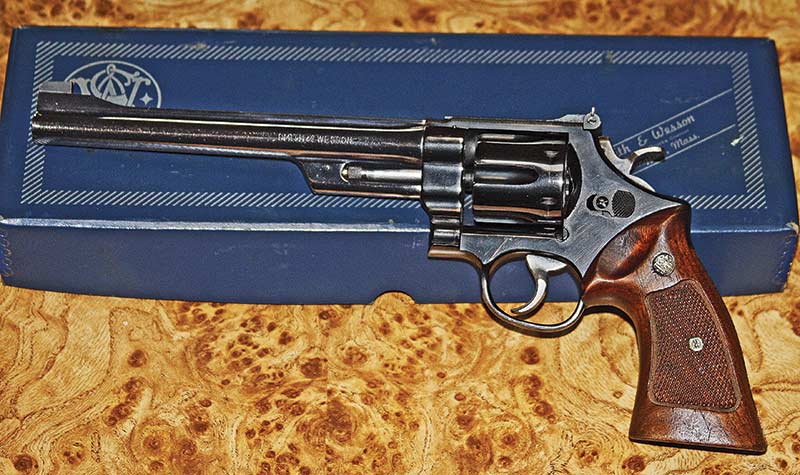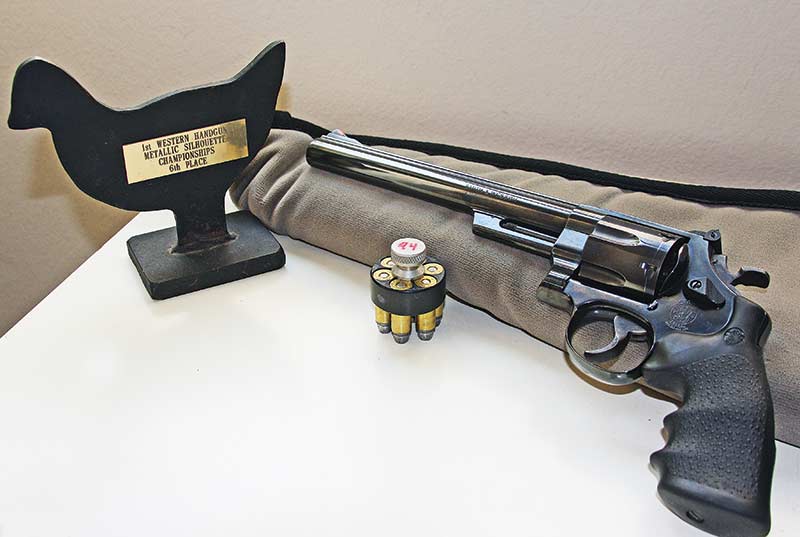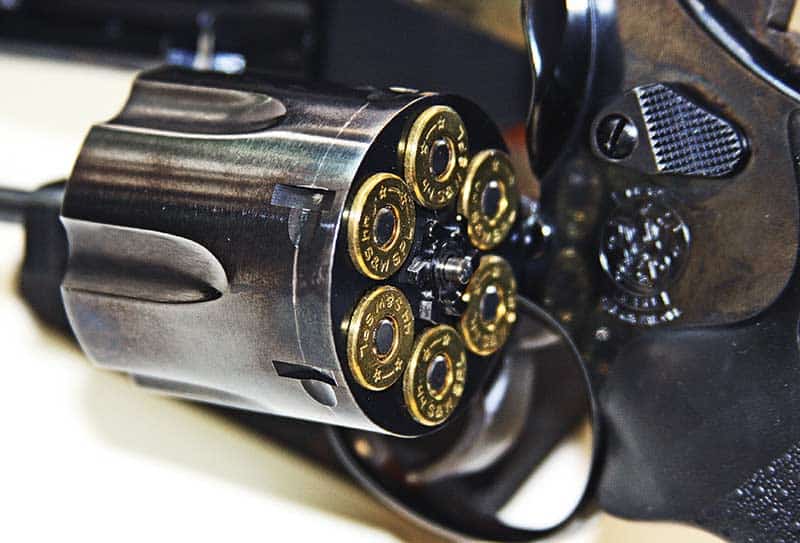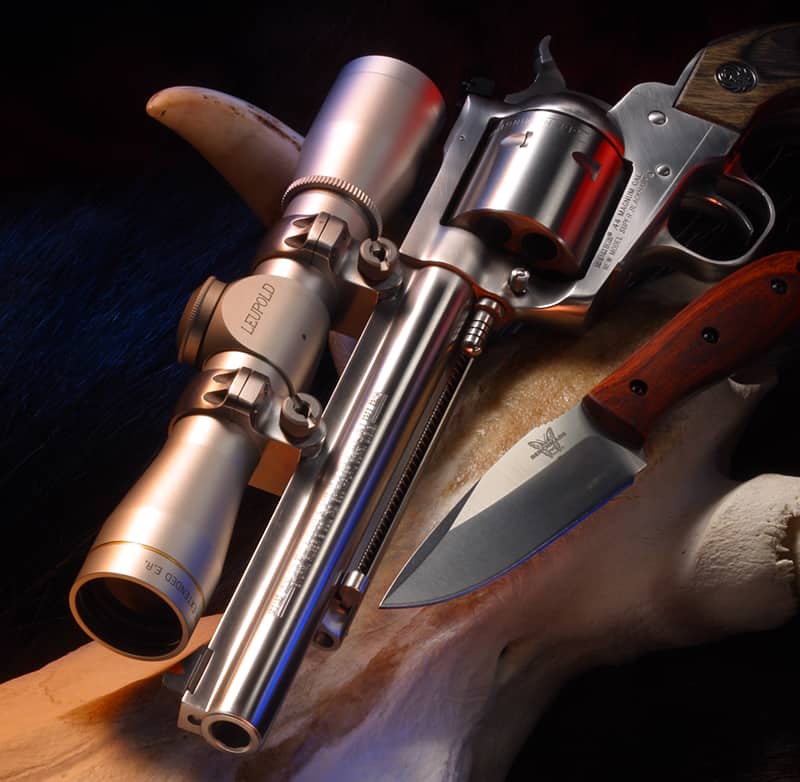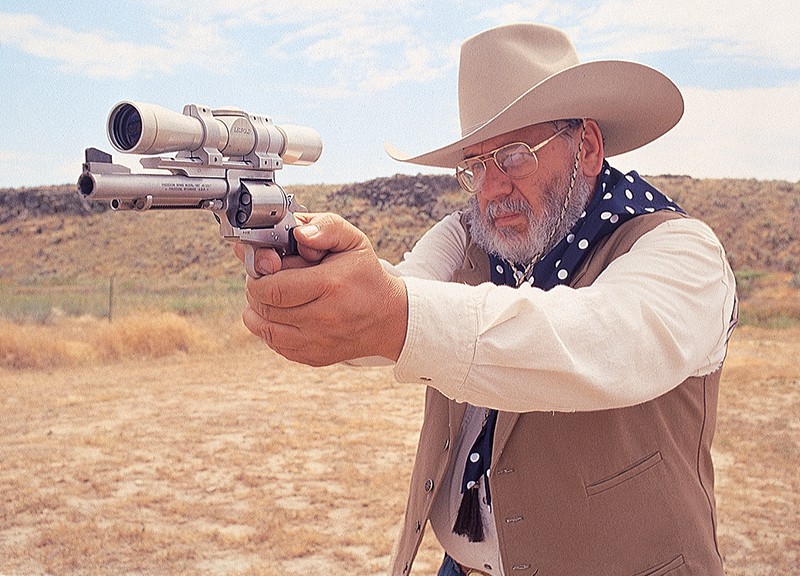Goddesses Of The Gun Vault
Dust ’Em Off And Put ’Em To Use!
Large handguns are impressive. They suggest massive power in terms of payload delivered — and felt recoil. Today’s oversized handguns began with the Walker Colt in the late 1840s and continued with N-Frame Smith & Wessons into the 20th century. The early Colts were working guns with no effort expended on cosmetics or sex appeal, relying simply on their intimidating effect on both shooters and shootees. Things changed in the 1930s when S&W called in makeup and wardrobe to work with their engineering department. The result was the original “S&W .357 Magnum” with adjustable sights and a beautiful finish. Early on, the best known model featured the 8 ⅜” barrel mostly because it was used on all the big game hunts depicted in the press releases and magazine stories of the day.
Despite the well-publicized hunting successes of the .357 Magnum, there was a cadre of gun writers who fervently believed truly big game demanded bigger bore calibers when hunted with handguns. This group of handgunners, most notably Elmer Keith, spent the next 20 years pushing S&W for a more powerful handgun, and in the mid-’50s, Smith obliged with the “The .44 Magnum” chambered in what was then the most powerful handgun cartridge in the world, oddly enough, the 44 Magnum.
Keep in mind this was pre-Dirty Harry, and the flagship model of the new handgun had a 4″ or 6.5″ barrel, with the 8 ⅜” following a few years later. By this time, the gun manufacturer had learned the importance of sex appeal in selling handguns, and while the guns were mass produced, they were built to be beautiful. Initially gun writers rejoiced, and the 44 Magnum was a hot item, until owners actually fired factory magnum loads. At this point many of the new models became “coffee table guns” and remained that way for 15 years — before Clint Eastwood “made Smith & Wesson’s day!”
The .41 Version
Elmer and his followers weren’t finished. Eight years after the introduction of the .44 Magnum (later named the Model 29), S&W came out with a slightly downsized, or “middle magnum” cartridge. It was the same frame, etc. of the .44 Magnum, but chambered in the new .41 Magnum, now designated as the Model 57. Since this was a time when all police departments carried revolvers, many gun writers advocated the new caliber as the “perfect police handgun.” S&W introduced a short-lived “Plain Jane” .41 Magnum model with fixed sights and a 4″ barrel called the Model 58.
While the police version was never officially adopted by more than a couple of departments (San Antonio, for one), the deluxe Model 57 did develop a following in the shooting community who appreciated the power yet liked the slightly reduced recoil. While it might not be accurate to say the .41 thrived, it did survive and continues to perform to this day.
My first “Buntline” S&W N-Frame with an 8 ⅜” barrel was a .44 Magnum acquired in the early 1970s shortly before the birth of handgun metallic silhouette shooting. Living in Southern California at the time, I was in the right time and place to attend the “First Western Regional Championship” in 1976. That was rather a grand title since the only other silhouette match ever held was the first International Championships hosted in El Paso the year before.
This was a formative period for the new sport, with guns and shooting positions still in the process of being defined. To make a long story short, I stuffed my .44 into a Bianchi shoulder holster, grabbed a couple boxes of home-brewed ammo and headed for the Angeles Shooting Range. I managed to finish in 6th place, and while that particular Smith Model 29 no longer resides in my house, the little trophy proudly does.
Within two months of that handgun silhouette match I had moved to Colorado, which at the time was both gun friendly and pro hunting. That original Model 29 played a big role in getting handgun silhouette matches organized on a state-wide basis plus it managed to take home a couple more trophies in the process. It also played a role in getting Colorado Fish and Game to approve big game handgun hunting. In subsequent years, the big Smith helped me harvest several deer and antelope in both Colorado and Wyoming.
Several of my shooting compadres did use long-barreled Model 57s chambered in the .41 Magnum. Perhaps it was for the reduced recoil or the .41 Magnum’s slightly flatter trajectory on the 150- and 200-meter turkeys and rams. I witnessed and experienced rear sights popping off .44 Magnums when the elevation screw reached the limits of its thread so a .41 might help to avoid that. I never purchased a Model 57 while living in Colorado, but my hunting partner of 60 years did, and I’ve seen him use it successfully on big game hunts and the silhouette range. They work just fine.
Back in the day, I think 210- or 220-grain jacketed bullets were the heaviest loads available for the 41 Magnum. J.D. Jones did some experimenting with heavyweight handgun bullets and praised their penetration ability on the toughest game. But it wasn’t until a few years later when Buffalo Bore and Corbon came out with factory loaded .41 Magnum ammo featuring 265-grain hard-cast bullets. These work and many of today’s commercial ammo manufacturers load heavy-for-caliber bullets in magnum calibers ranging from .32 up through .500.
The .357 Magnum
Fairly recently I acquired the original queen of the S&W family goddesses, the Model 27. As the first of her species, she didn’t need a number; she was called simply “The 357 Magnum”! With her slightly slimmer barrel, finely cross-hatched top strap to reduce glare, and Patridge front sight blade, she was a thing of rare and special beauty. The rear face of her front sight blade was vertical rather than ramped and lacked the classic red plastic insert used on later models. With any reasonable ambient light, there’s no finer sight picture available with irons.
Admittedly “the queen” does not have the glassy smooth DA trigger pull of a revolver having had an action job by a good gunsmith. While occasionally I will fire a DA follow-up shot on wounded game, my protocol is to achieve a precisely placed first shot firing single action.
I was always a bit shy about using anything other than a “big bore” for hunting, though. I had an opportunity to hunt whitetail deer in Texas shortly after acquiring the Model 27, which struck me as the perfect opportunity to verify the gun’s pedigree and see about that caliber concern of mine. The elderly queen was still almost bank vault tight, and performed well on the range with factory 158-grain JSP bullets. Just before dark on a balmy night in the Texas panhandle, I had a plump doe approach broadside to within 50 yards of where I was seated. The first shot put her down immediately, while the second shot finished the hunt — putting my concerns to rest once and for all.
You can still buy a variety of DA revolvers from S&W chambered in all three of the original magnums — some of which may one day become new classics. If you’re looking for one of the earlier models though, you’ll need to do some serious shopping. Perhaps even get off the computer and visit a non-virtual gun store with used guns. I can’t emphasize how special it is to go hunting with a goddess!

Get More Revolver Content Every Week!
Sign up for the Wheelgun Wednesday newsletter here:
